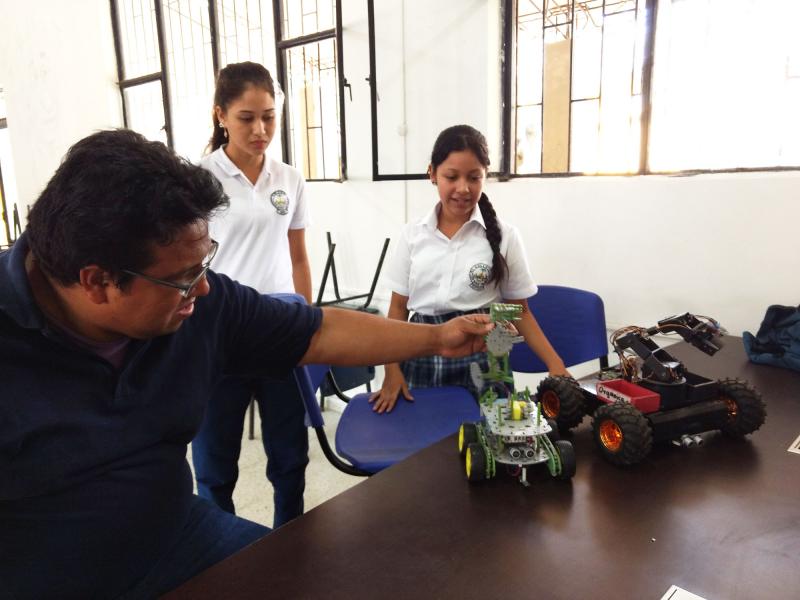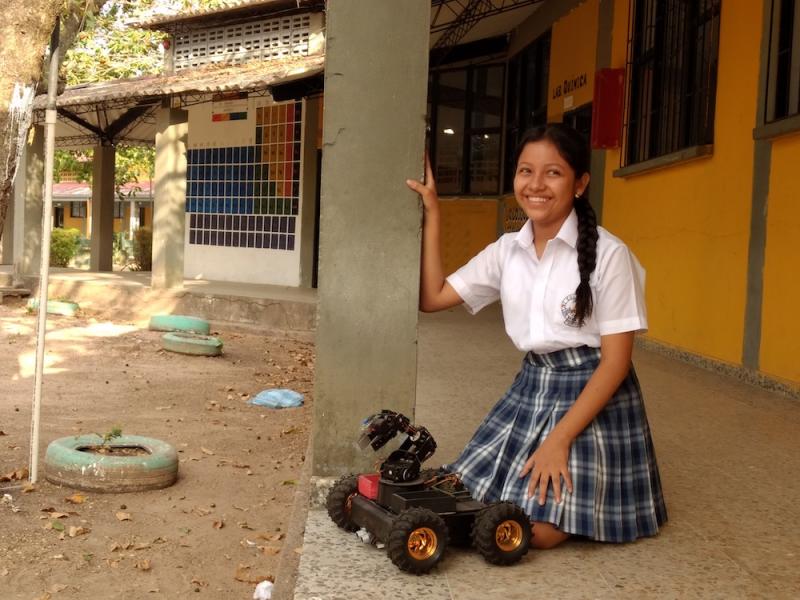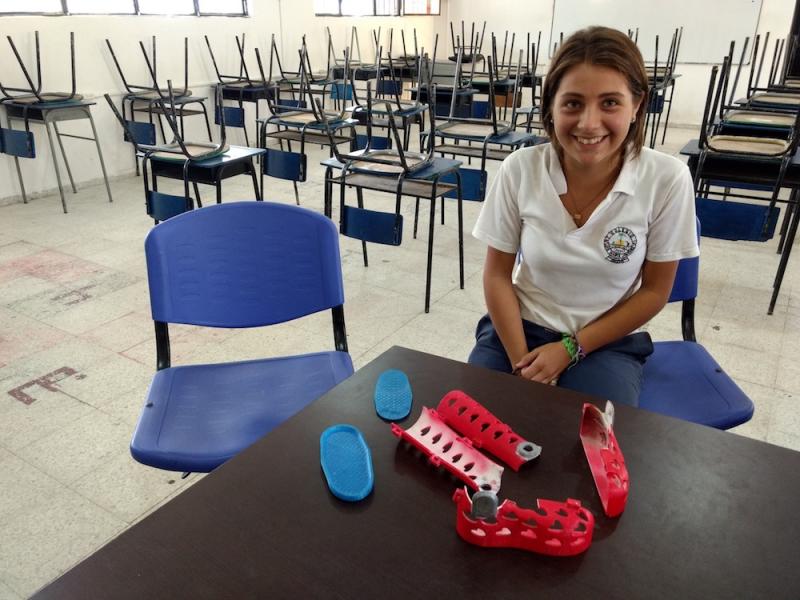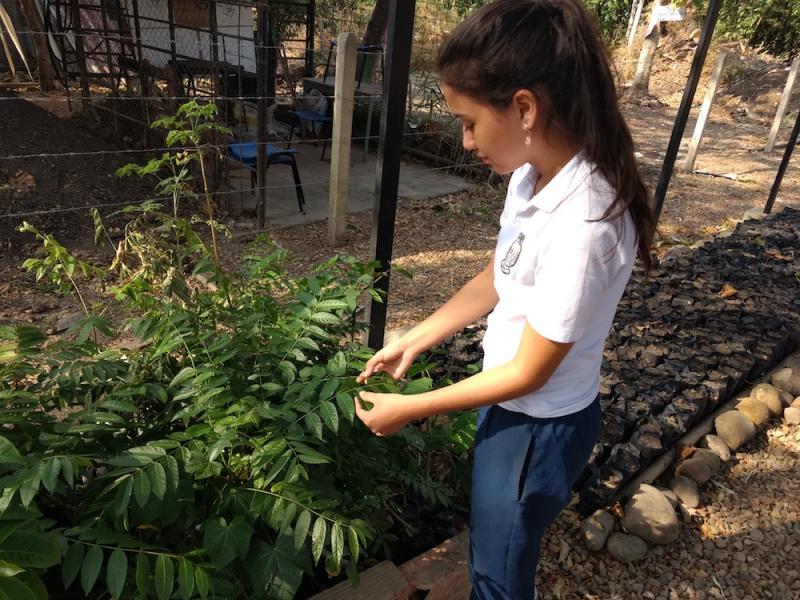In an isolated part of Colombia better known for rice, pineapples, and paramilitaries, something else is taking root: the next generation of female scientists.
In 2016, Colombia’s government signed a peace treaty with the FARC guerilla group to bring an end to the country’s 50-year civil conflict — but the scars and traumas of that era echo throughout the countryside.
As Sojourners visited the tiny town of San José del Bubuy, in Casanare department (state), physicist turned school teacher Jhon Vega tells of some of the challenges in this new era.
“I came here 10 years ago and found maths hard to teach. Because we are here in this rural school, often students don’t have TV, internet, or even sometimes, electricity at home,” he said.
He says that 40 percent of the population of this area have at some point been involved with paramilitary groups, but that these days, things are “calmer.”
Through Vega’s efforts, his school has transformed a tiny program with two students in 2011 into one of more than 30 students who participate in a range of programs, including a Saturday morning program that attracts girls and boys alike.
jhon.jpg

Thanks to the efforts of many, including Ana Sofía Pinzón, a microbiologist originally from the area, programs like Vega’s are made possible across Casanare, in Colombia’s sprawling savannahs.
This is key because according to UNESCO statistics, in 2015, only 38.4 percent of scientists in Colombia were female.
But there are signs of hope. Colombia became a member of the OECD in 2018, and Colombia is one of the few countries where at least one-third of graduates in the fields of engineering, manufacturing, and construction are women compared to the OECD average of 28 percent. Also in Colombia, 29 percent of computing graduates are women, far outpacing the OECD average of 20 percent.
Robots and 3D printing
In a school named after Luis Maria Jimenez, a violently slain ex-mayor of the municipality, Sojourners met with three of the female students who participate in Robtronics, an extra-curricular science group that meets on Saturday mornings, run by Vega on a shoestring budget.
Daniela Benavides shows off the robots that she and her fellow students constructed. The different models of robots show a clear progression from simple, lego-like models, to a slick black prototype that looks like it would be at home on the surface of Mars.
daniela.jpg

“My sister Erika was always playing around with robots and that’s how I got interested in them,” she said.
The shy 12-year-old says that the science group feels like “a family” and that she is already keen to go on to study after high school.
Also in the classroom is Anyi Manco, 15, who is continuing a project to provide 3D-printed orthopedics to a 5-year-old girl who can't walk well.
Vega said that the school was able to acquire a 3D printer but progress has been slow as they don’t have a high-end computer to go with the printer.
Despite that, they have been able to print out foot and leg braces that were tailored to the dimensions of their tiny patient.
“I like medicine and I like that we are coming up with ways to help people,” Manco said.
Manco says the next step is to make the 3D-printed plastic a more comfortable fit for the toddler.
Using the printer, the kids also designed and produced key rings in the shape of their school crest and the logos of teams in the popular national soccer league.
anye.jpg

Green power
In the school’s garden, which doubles as an agricultural teaching lab, Shirley Moreno, 15, shows off some of the native plants that the school grows in order to help preserve local biodiversity.
Moreno, who lives far into the country, is working on getting electricity out of soil microbes living with native Colombian plants — using the byproducts of photosynthesis to charge a 9-volt battery.
The project started two years ago after Moreno and her friends saw something similar on the internet.
shirley.jpg

Through the program, Moreno was able to take one of her projects to Colombia’s national science fair, held hundreds of kilometres away in the country’s capital of Bogota – and win.
“It was such a surprise, because the other schools that were being announced as third and second prize were rich, private schools,” she said.
Another pleasant surprise in Bogota was, Moreno says, to see so many female-led teams.
“In Colombia, we live in a 100 percent machista [machismo-driven] society. But you can see in other parts of the world, men and women working together and when women are supported, things are changing,” she said.
On to great things
Vega says that despite university options being limited in this largely rural part of Colombia, four of the female students have gone on to study at university: two alumnae entered into electronics and one each into environmental engineering and medicine.
The young scientists of San Jose de Bubuy also have some home-grown Colombian role models to look up to.
Nubia Muñoz, born in the southern Colombian city of Cali, was the first to establish the epidemiological relationship between the human papilloma virus (HPV) and cervical cancer, which in turn spurred on the development of vaccines against the disease, which has an especially high incidence among women in developing countries.
Another role model could be Paola Guerrero a young physicist from the industrial city Bucaramanga in Colombia’s east. As part of a leadership initiative called Homeward Bound, she went to Antarctica with 75 other women with science, technology, engineering, and mathematics (STEM) background. She’s toured Colombia giving talks to kids about her journey and promoting a message of sustainability.
And there is more and more international attention on efforts to girls to enter into –and stay in– science, beyond February 11, International Day of Women and Girls in Science, or March 8, International Women’s Day.
Recently, hundreds of female entrepreneurs gathered in Medellin to hear about how women and girls are becoming more involved in science and technology.
Back at the school, Vega and the girls go back to class, all smiling for having the chance to have shared their passion for science.
Got something to say about what you're reading? We value your feedback!








